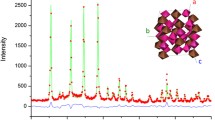Abstract
In this paper, we report results of thermoanalytical investigation on the reaction between ZrOCl2·8H2O and (NH4)2HPO4 in molar ratio 1:2. Differential thermal-thermogravimetric and X-ray diffraction analyses were performed in order to reveal the chemical transformations, which took place during heating of the individual compounds ZrOCl2·8H2O, (NH4)2HPO4 and the mixture ZrOCl2·8H2O:2(NH4)2HPO4. It was shown that the transformations in the mixture below 160 °C were connected with dehydration of ZrOCl2·8H2O and interaction between the components of the mixture, which resulted in the formation of NH4Cl, NH4H2PO4 and a mainly amorphous zirconium phase, most likely t-ZrO2. The zirconium component subsequently reacted with ammonium dihydrophosphate (below 200 °C) or with dehydrated phosphate derivatives (above 200 °C), which in both cases yielded an amorphous product. The interaction between the components of the mixture resulting in the formation of ZrP2O7 was completed by its crystallisation at 610 °C. Our study indicates an alternative low-temperature approach for the synthesis of the technologically important ZrP2O7 material.







Similar content being viewed by others
References
Ota T, Yamai I. Thermal expansion of ZrP2O7 and related solid solutions. J Therm Sci. 1987;22:3762–4.
Chen F, Shen Q, Schoenung JM, Zhang L. Synthesis and pressureless sintering of zirconium phosphate ceramics. J Am Ceram Soc. 2008;91:3173–80.
Al-Zahrani SM, Elbashir NO, Abasaeed AE, Abdulwahed M. Oxidative dehydrogenation of isobutane over pyrophosphate catalytic systems. Catal Lett. 2000;69:65–70.
Srilakshmi Ch, Ramesh K, Nagaraju P, Lingaiah N, Prasad PSS. Studies on preparation, characterization and ammoxidation functionality of zirconium phosphate-supported V2O5 catalysts. Catal Lett. 2006;106:115–22.
Pelova V, Grigorov L, Bogatchev G. Luminescence of Tb3+-activated zirconium pyrophosphate: influence of compensating and sensitizing impurities. J Mater Sci Lett. 1997;16:161–4.
Kim CH, Yim HS. The effect of tetravalent metal on dielectric property in ZrP2O7 and TiP2O7. Solid State Commun. 1999;110:137–42.
Birkedal H, Andersen AMK, Arakcheeva A, Chapuis G, Norby P, Pattison P. The room-temperature superstructure of ZrP2O7 is orthorhombic: there are no unusual 180 degrees P-O-P bond angles. Inorg Chem. 2006;45:4346–51.
Andersen AM, Norby P. Ab initio structure determination and rietveld refinement of a high-temperature phase of zirconium hydrogen phosphate and a new polymorph of zirconium pyrophosphate from in situ temperature-resolved powder diffraction data. Acta Crystallogr. 2000;56B:618–25.
Sclar CB, Carrison LC, Schwartz CM. High-pressure polymorph of zirconium pyrophosphate. Nature. 1964;4958:573–4.
Chernorukov NG, Korshunov IA, Zhuk MI. Thermal stability of crystal zirconium and hafnium phosphates. Works Chem Chem Technol. 1974;3:7–8.
Seyyidogle S, Ozenbas M, Necmeddin Y, Yilmaz A. Investigation of solid solution of ZrP2O7-Sr2P2O7. J Mater Sci. 2007;42:6453–63.
Watanabe M, Sakurai M, Yamada T, Mori H. Synthesis and thermal properties of zirconium ortho- and diphosphates. J Mater Sci. 1996;31:2569–72.
Stinton GW, Hampson MR, Evans JSO. The 136-atom structure of ZrP2O7 and HfP2O7 from powder diffraction data. Inorg Chem. 2006;45:4352–8.
Parhi P, Kramer JW, Manivannan V. Synthesis and characterization of zirconium diphosphate by microwave assisted metathesis approach. Mater Sci Eng B. 2008;153:53–6.
Samed AJ, Zhang D, Hinokuma S, Machida M. Synthesis of ZrP2O7 by hydrothermal reaction and post-calcination. J Ceram Soc Jap. 2011;119:81–4.
Zhao D, Deng X, Ding Z, Wang H, Ma G. Intermediate temperature ionic conduction in Mg2+-doped ZrP2O7 ceramics. Solid State Ionics. 2012;229:33–7.
Völlenkle H, Wittmann A, Nowotny H. Über Diphosphate vom Typ Me(IV)P2O7. Monatsh Chem Verw Tl. 1963;94:956–63.
Takagi S. Zirconium compounds. I. Thermal decomposition of zirconium chloride octahydrate. J Chem Soc Japan 1954;75:637-9.
Beden B, Guillaume I. Thermal decomposition in air of zirconium chloride octahydrate. Compt Rend Ser. 1969;269C:1629–32.
Beden B, Guillaume I. Thermal decomposition under controlled pressure of zirconium chloride octahydrate. J Thermal Anal. 1974;6:131–44.
Makushina NI, Petrov ES. Thermal decomposition of zirconium oxychloride. Izv Sib Otd Acad Nauk SSSR Ser Khim Nauk. 1967;3:63–6.
Guerrant GO, Brown DE. Thermal stability, thermal decomposition of high-analysis fertilizers based on ammonium phosphate. J Agr Food Chem. 1965;13(6):493–7.
Van Wazer JR. Phosphorus and its compounds. New York: Interscience publishers; 1958.
Hudry D, Rakhmatullin A, Bessada C, Bardez I, Bart F, Jobic S, Deniard Ph. Reactivity of NH4H2PO4 toward LaCl3 in LiCl-KCl melt flux. Step by step formation of monazite-like LaPO4. Inorg Chem. 2009;48:7141–50.
Abdel-Kader A, Ammar AA, Saleh SI. Thermal behaviour of ammonium dihydrogen phosphate crystals in the temperature range 25–600 °C. Thermochim Acta. 1991;176:293–304.
Bielanski A. Fundamentals of inorganic chemistry. Warszawa: PWN; 1998.
Stefanic G, Music S, Popovic S, Furic K. Formation of ZrO2 by the thermal decomposition of zirconium salts. Croat Chem Acta. 1996;69:223.
Acknowledgements
The Ministry of Education, Youth and Sports of the Czech Republic, Project CZ.1.07/2.3.00/30.0021 “Enhancement of R&D Pools of Excellence at the University of Pardubice”, financially supported this work.
Author information
Authors and Affiliations
Corresponding author
Rights and permissions
About this article
Cite this article
Gorodylova, N., Šulcová, P., Bosacka, M. et al. DTA-TG and XRD study on the reaction between ZrOCl2·8H2O and (NH4)2HPO4 for synthesis of ZrP2O7 . J Therm Anal Calorim 118, 1095–1100 (2014). https://doi.org/10.1007/s10973-014-3890-4
Received:
Accepted:
Published:
Issue Date:
DOI: https://doi.org/10.1007/s10973-014-3890-4




